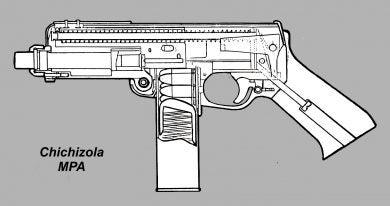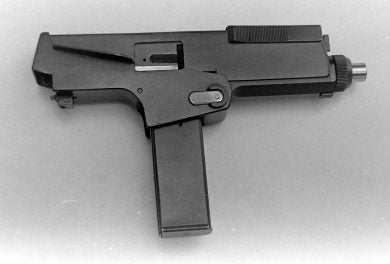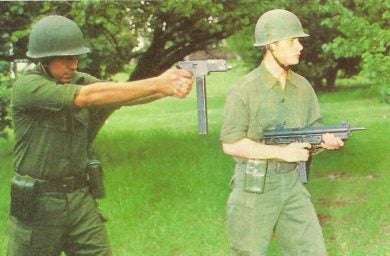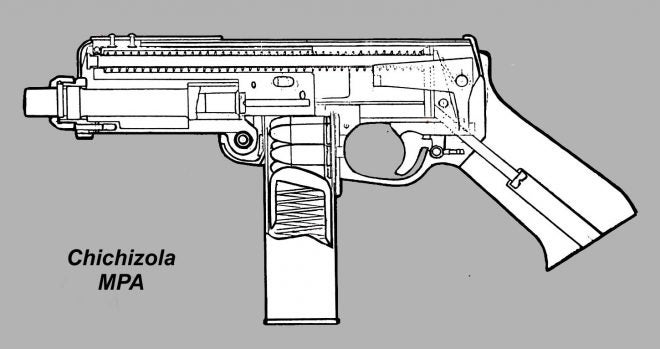In 1977, the urge of “firepower, compact style” showed up again at Fábrica Militar de Armas Portátiles “Domingo Matheu”, one more time as an in-house private venture. Designer Enrique Chichizola started studying technical approaches to an automatic-fire gun of small dimensions capable of achieving such stability and controllability characteristics so as to allow effective target hit probability at realistic ranges (say, up to 10 meters). He called it the MPA (Mini Pistola Ammetralladora, Mini Machine Pistol).

Cut-away drawing of Enrique Chichizola’s MPA with an 18-round magazine in place. Note the well-inclined configuration of the pistol grip.
His approach could well be called “ergomechanic”, since a deeper interface between firer and machine was involved. It basically consisted of aligning the gun barrel’s axis as much as possible with the firing hand’s supporting point with views at reducing the respective force momenta (during firing) of the gun’s center of gravity and the shooter’s hand/arm. This resulted in the adoption of a specially designed pistol grip that was just about an extension of the receiver’s rear end, with a generally conventional trigger/trigger guard assembly just ahead of it. Chichizola had, in fact, considered other more unconventional solutions, one of these being the replacement of the trigger proper by a thumb-activated lever on the receiver’s side, not to mention what he considered to be the ideal answer: a sort of spade grip at the very rear end of the receiver! This, in the event, was not even tried, as it might have appeared too revolutionary for the FMAP management, who could politely have asked the designer to stop… designing.

What was left of the first MPA on top of a 1:1 scale drawing of the pistol. The long 40-round magazine sketched was apparently used for photographic purposes, only.
Well, the MPA was otherwise a rather conventional blowback affair firing 9x19mm ammo out of a 105mm long barrel that sat pretty low in the boxlike receiver. A very high cyclic rate of fire (1,500 to 2,000 rounds per minute) was intended to take advantage of the principle that that in a rapid and short (3 to 4 rounds) burst, by the time the firing momentum starts rising the muzzle, the bullets are already in their way to the target. So, a lightweight (320 grams) bolt was used, whose guide rod and stiff return spring were in the upper position. At the breech-closing moment, the bolt would be well forward in the receiver, ahead most of the barrel’s length, thus giving a definite downward push at the muzzle end. Ejection was to the right.

The right side view of the Chichizola prototype main body (18-round magazine in place) shows the small ejection port and the pressed-steel cocking piece on the forward top of the receiver.
The gun used staggered-row, two-position feed, metal box magazines of 18- and 25-round capacities, an even a 40-round unit was occasionally fitted (apparently, for photographic purposes, only). The catch release button was located just ahead of the magazine well, being pressed inwards (left to right) to release the magazine. It was located within the disassembly pin which allowed the upper and lower receiver assemblies to come apart. The cocking piece was a pressed-steel structure of pretty low profile involving the top of the receiver.

An internal publicity photo showing the MPA prototype a with a 40-round magazine, alongside a 9x19mm FMK.3 submachine gun that was series produced (estimated 30,000 examples) for several years at FMAP “Domingo Matheu”, in Rosario, Santa Fé Province.
A single prototype was put together in Rosario and proved its point well. Although a controlled burst device was actually built, it was never fitted into the MPA, magazines loaded with four rounds only simulating it for testing purposes. Chichizola told me, years later, that single-handed shooting at man-sized silhouettes at 12 meters – that is, well over the close-in ranges anticipated for that sort of firearm — generally resulted in the four bullets impacting in the kill zone, which appeared to confirm that muzzle raise was very modest, indeed.
However, and unfortunately, the full-auto pistol prototype did not receive further (or any, in fact) support from Army guys outside the factory gates, and the whole testing program slowly came to an end.
 Your Privacy Choices
Your Privacy Choices
